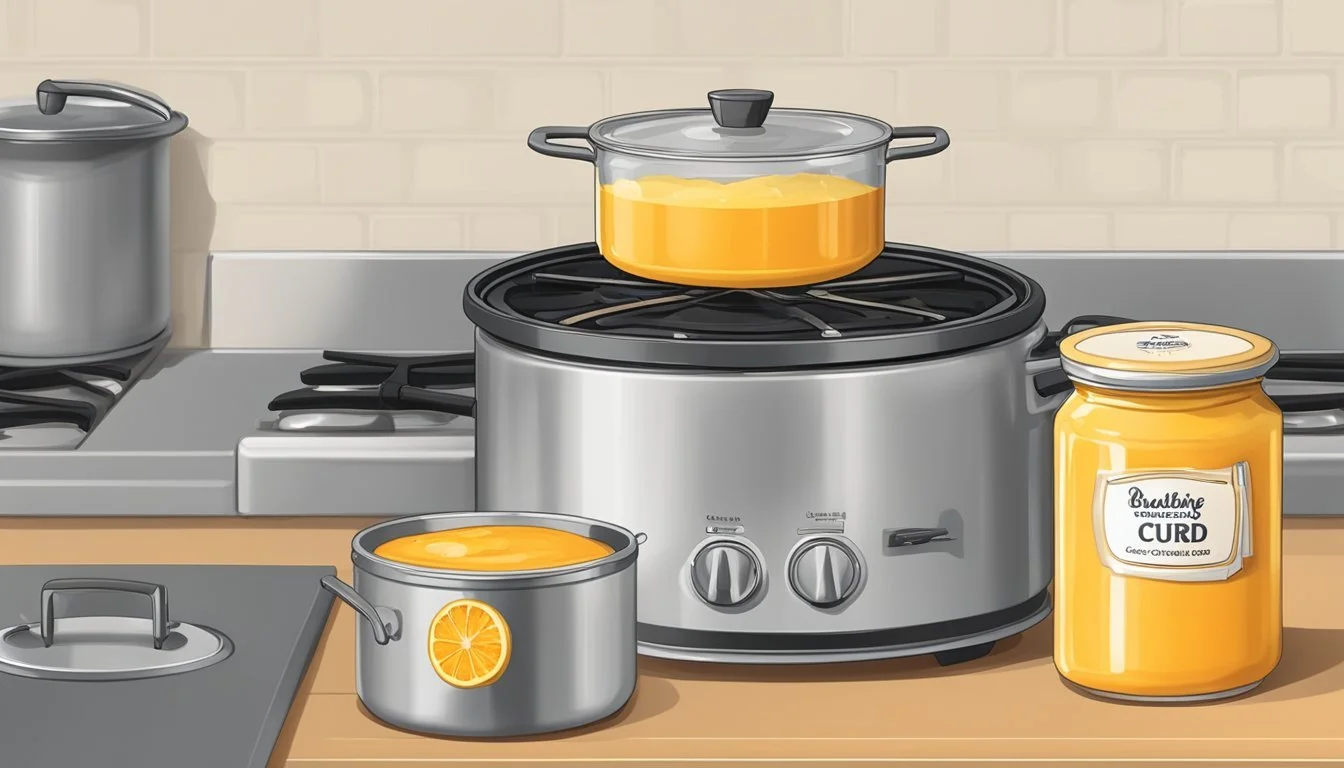How Long Does Canned Orange Curd Last?
Shelf Life and Storage Tips
When considering the longevity of canned orange curd, a delightful dessert enhancer known for its vibrant flavor and smooth texture, one should note that the preservation of this citrus-based condiment is influenced by several factors. At its core, orange curd consists of a rich blend of sugar, orange zest, and juice, often combined with eggs or other stabilizers to create its signature creamy consistency.
Homemade orange curd typically offers a fresher taste but has a shorter shelf life compared to commercially canned versions. If the homemade curd is stored properly in an airtight container in the refrigerator, it generally lasts for up to two weeks. The commercial canning process, however, involves rigorous sterilization and sealing techniques that extend its shelf life considerably, allowing it to remain unspoiled for months or even years as long as the can's integrity remains uncompromised.
The high sugar content in orange curd acts as a preservative, contributing to its shelf stability. However, once opened, the curd should be treated as a fresh product, with its longevity resembling that of homemade curd due to its exposure to bacteria once the seal is broken. For best texture and flavor, consumers are advised to use the opened curd within a couple of weeks and to always employ clean utensils when serving to prevent contamination.
Nutritional Content and Benefits
Canned orange curd, a delightful spread made with essential ingredients such as eggs, sugar, and butter, offers a bold orange flavor often associated with a high calorie and sugar content. This section delves into its nutritional profile and health considerations.
Caloric Information
Orange curd is energy-dense due to its high sugar and butter content. A typical serving size can have:
Calories: Approximately 60-100 per tablespoon.
Total Fat: Around 2-5 grams, influenced by the amount of butter.
Sugars: Approximately 9-14 grams per tablespoon, reflecting the high sugar composition.
Health Considerations
While orange curd provides certain nutritional benefits such as vitamin C from the oranges and protein from the eggs, it should be consumed in moderation due to the following:
Sugar Content: High levels of sugar can increase the risk of weight gain and dental issues.
Fat: With butter as a key ingredient, the spread has a significant amount of saturated fat, which affects cholesterol levels.
Homemade versus Store-Bought: Homemade orange curd may have a lower amount of preservatives and additives, potentially offering a healthier option, as the consumer can control the ingredients such as salt and sugar. However, the nutritional content largely depends on the recipe used.
Making Orange Curd
Creating homemade orange curd involves a balance of ingredients and technique to achieve the perfect flavor and consistency. This citrus curd can vary in color and taste, depending on the type of oranges used.
Ingredients and Ratios
Oranges: For a rich flavor, cara cara oranges or blood oranges are preferred due to their vibrant color and sweetness.
Sugar: Essential for balancing the tartness.
Butter: Gives the curd a creamy texture.
Eggs: Acts as a thickening agent.
Lemon Juice: Can be added for extra tartness.
Salt: Enhances the overall flavor.
Zest: Adds an intense citrus aroma and flavor.
The ratios are typically as follows:
Ingredient Quantity Orange Juice ⅓ cup Sugar 1 cup Butter ½ cup (1 stick) Eggs 2-3 whole eggs, or 4-6 yolks Lemon Juice 1 tbsp (optional) Salt pinch Orange Zest 1 tbsp
Cooking Techniques
The cooking process involves whisking together eggs, sugar, and orange zest until well combined. The juice, and sometimes a pinch of salt or a splash of lemon juice, is then added. The mixture is cooked over low to medium heat, constantly stirring to prevent the eggs from scrambling. A double boiler can be used to ensure the mixture does not overheat. Once thickened to the desired consistency, the mixture is taken off the heat, and butter is stirred in until melted and incorporated.
One should always whisk continuously to ensure a smooth texture and to avoid any lumps. The curd is done when it can coat the back of a spoon and reaches a safe eating temperature, typically around 160 degrees F. It's crucial to avoid boiling as this can cause the eggs to curdle.
Homemade Vs. Store Bought
Homemade orange curd generally has a superior flavor and texture when compared to store-bought varieties. Homemade curd offers the advantage of using fresh ingredients and can be adjusted for sweetness and tanginess. Blood oranges or cara cara oranges not only add a distinct taste but also a vibrant color that is often not replicated in commercial curds.
With homemade curd, one controls the quality of the ingredients, ensuring no preservatives or artificial flavors are added. However, store-bought orange curd can be a convenient option with a consistent quality and a longer shelf life. It’s important to note that the quality of store-bought curd can vary greatly between brands.
Storage Fundamentals
Proper storage is crucial for maintaining the quality and safety of canned orange curd. Specific guidelines for refrigeration and procedures for freezing and thawing are pivotal in ensuring the curd retains its intended consistency and texture.
Refrigeration Guidelines
Canned orange curd should be stored in the refrigerator once opened to maximize its shelf life while maintaining safety and flavor. Key points include:
Temperature: Keep the refrigerator at 40°F (4°C) or below.
Airtight container: Transfer the curd to an airtight container if it's not in a resealable jar.
Shelf life: Consume orange curd within 3 to 4 months for best quality.
Labeling: Place a label with the date of opening on the container to track how long it has been stored.
Freezing and Thawing Procedures
Freezing is not typically recommended for canned orange curd due to potential changes in texture. If one chooses to freeze it, they should:
Container: Use an airtight container leaving some space to account for expansion when freezing.
Freezer: Set the freezer temperature at 0°F (-18°C) or lower for optimal food safety.
Thawing: Thaw frozen orange curd in the refrigerator, not at room temperature, to maintain safety and avoid bacterial growth.
Consistency: After thawing, the consistency may change; stirring may be necessary to even out texture.
Shelf Life and Spoilage
When it comes to canned orange curd, understanding its shelf life and identifying spoilage signs are crucial to ensure both optimal taste and food safety. The shelf life of canned goods, including orange curd, is greatly influenced by the storage conditions applied after canning.
Identifying Spoilage
One can identify spoilage in canned orange curd through several distinct signs:
Smell: An off odor is a clear indicator that the curd should not be consumed.
Liquid: Separation or discoloration of the liquid within the jar suggests spoilage.
Mold: Any visible mold growth on the curd itself or under the lid requires immediate disposal of the product.
Can Integrity: Swelling, leaking, or rusting cans signal potential contamination and should lead to discard.
Best By Date Vs. Safety
The labeling on canned goods, like orange curd, provides a "best by" date which is primarily about quality rather than safety:
Pantry: A "best by" date suggests that canned orange curd will maintain best quality when stored in a cool, dry pantry prior to opening.
Refrigerator: Once opened, orange curd's shelf life can range between 2-4 weeks if kept in an airtight container and refrigerated.
Stored Properly: Regardless of the "best by" date, if the orange curd is stored properly, it may remain safe to consume beyond the date.
Food Safety: It is critical to understand that dates do not guarantee safety; signs of spoilage due to improper storage conditions, such as oxidation and botulism, should always override date-based judgments. If in doubt, it is safer to discard the preserve.
Applications in Culinary Delights
Canned orange curd, a versatile citrus-based spread, offers a delightfully tart yet sweet flavor. It adds a twist to various recipes, enhancing traditional desserts with its fresh, citrusy taste.
Desserts and Sweet Dishes
Canned orange curd shines as a filling for countless dessert applications. Its bright flavor complements the buttery crust of tarts and offers a citrus-infused alternative to lemon curd in sunny versions of cheesecake. When spread between layers, it gives cupcakes a tangy surprise, and can be swirled into ice cream for an unforgettable homemade treat.
Dessert Illuminate Table:
Dessert Type Application Flavor Impact Tarts Filling Citrusy Cupcakes Layering Tangy Ice Cream Swirling Refreshing Cheesecake Topping Bright
Breakfast Combinations
Transforming breakfast items into gourmet experiences, canned orange curd pairs beautifully with pancakes, waffles, and scones. A dollop atop a warm, fluffy pancake invites a zesty start to the morning. Spread it on toasted bread for a simple yet vibrant alternative to strawberry jam.
Breakfast Enhancers List:
Pancakes with a zesty orange curd topping
Waffles made richer with a spoonful of citrus spread
Scones served with a side of sweet orange curd
Creative Condiment Uses
Beyond desserts and breakfast, orange curd doubles as a creative condiment. It can serve as a tangy filling in snack bars or a surprise ingredient in salsa, giving a nod to citrus fruits like tangerine and lemon. The curd can invigorate traditional flavors with its distinct taste, melding exceptionally well in both sweet and savory contexts.
Condiment Exploration Bullets:
Snack bars with orange curd filling for an energizing bite
Salsa with a twist, incorporating a spoonful of orange curd for extra zest
Canning and Preservation Techniques
The preservation of orange curd through canning relies on meticulous safety measures, correct processing methods, and proper storage practices to ensure the homemade product's quality and edibility.
Safety in Canning
Canning, especially when dealing with homemade citrus curds like orange curd, mandates strict adherence to food safety protocols. One must use a calibrated thermometer to ascertain that the canning process reaches temperatures high enough to eliminate hazardous bacteria. All equipment, including mason jars, lids, and canning utensils, should be sterilized before use. It is crucial to follow up-to-date home canning guidelines to minimize the risk of foodborne illness.
Process of Canning Orange Curd
The procedure of canning orange curd involves:
Preparing the curd as per a tested and reliable recipe, maintaining consistent stirring to prevent overcooking.
Filling sterilized mason jars with the curd, leaving an appropriate headspace to allow for expansion.
Wiping the jar rims and securing the lids to ensure a proper seal, crucial for the preservation process.
Processing the filled jars in a boiling water canner for the time specified by the recipe, monitoring with a thermometer to ensure the temperature is constant.
Storage After Canning
Once canned, the orange curd should be stored in a cool, dark place, between 50 and 70 °F to maintain quality. The storage area should be dry, and the jars should not be exposed to temperatures above 95° F to prevent spoilage. Typically, home-canned orange curd will have a shorter storage life compared to other canned goods, hence it is recommended to consume it within 3 to 4 months for best quality.








